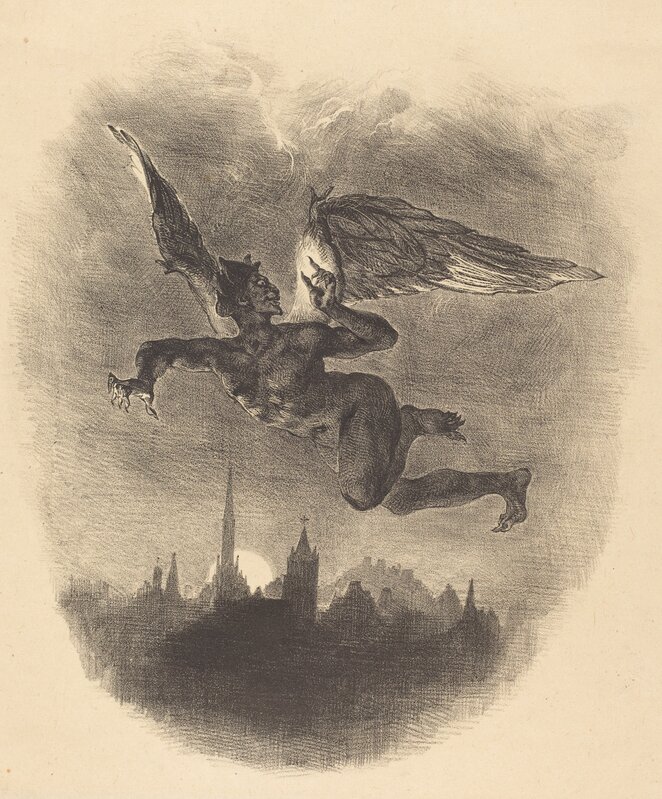Art history reflects humanity’s mythological and religious fears, desires, and conflicts. The figure of the devil has been frequently portrayed by artists throughout this history, appearing sometimes as a terrifying entity, at other times as an alluring figure, or even as an allegorical character. The representation of the devil has evolved in accordance with the changing dynamics of art and society over the centuries. In this article, we will examine the evolution of the devil in art history, exploring the transformations of this figure through the works of prominent painters.
The Middle Ages: A Symbol of Fear and Religious Control
In medieval art, the devil was depicted as a tool to frighten people and enforce religious authority. Since the church controlled art during this period, representations of the devil often revolved around depictions of hell, demonic figures, and the punishment of sinners. The devil emerged as a figure that embodied everything opposed to Christian teachings, defining the boundaries of faith.

(Hieronymus Bosch - The Garden of Earthly Delights, 1490-1510)
The Renaissance: A Fusion of Mythological and Religious Themes
The Renaissance saw a resurgence of interest in ancient Greek and Roman mythology, placing human experience at the center of art. During this period, the devil was not merely a frightening figure but was also reinterpreted as a symbol of humanity’s internal struggles. In Michelangelo’s The Last Judgment fresco, the devil is depicted as a judge overseeing the condemned souls in hell. However, this judgment is more reflective of humanity’s moral dilemmas and inner conflicts.

(Michelangelo - The Last Judgment, 1541)
The Baroque Period: Dramatic and Theatrical Interpretations
The Baroque period introduced a dramatic, extravagant, and dynamic style in art. During this era, the devil was portrayed both as an aesthetic element and as a figure meant to leave a profound impact on the viewer. Baroque artists used intense contrasts of light and shadow to create an emotional experience when depicting the devil and hell. Peter Paul Rubens’ The Fall of the Damned illustrates how the devil was both aestheticized and dramatized during this period. In the painting, the damned souls and the devil guiding them exhibit great movement and dynamism.

(Peter Paul Rubens - The Fall of the Damned, 1620)
The Romantic Era: Exploring Inner Darkness
The Romantic era emphasized emotions, nature, and the individual’s inner world. During this period, the devil represented the darker, rebellious side of the human spirit. Goethe’s Faust illustrates how the devil (Mephistopheles) was reimagined not merely as a terrifying entity but as a sophisticated figure that challenges and tempts humanity. Eugène Delacroix’s Mephistopheles in the Air depicts the devil as both an alluring and dangerous character, reflecting the era’s perception of the devil.

(Eugène Delacroix - Mephistopheles in the Air, 1828)
Modern and Contemporary Era: Psychological and Symbolic Interpretations
In the modern era, artists began to interpret the devil from a psychological and symbolic perspective. The devil transformed into a metaphor for inner fears, societal pressures, and moral dilemmas. Francisco Goya’s The Witches’ Sabbath shows how the devil became less of a terrifying figure and more of a symbol for humanity’s internal darkness and societal criticism.

(Francisco Goya - The Witches’ Sabbath, 1789)
Conclusion: The Evolution of the Devil’s Depiction
The depiction of the devil in art history reflects the cultural, religious, and social dynamics of each era. From the Middle Ages to the modern period, the portrayal of the devil shows how artists and societies interpreted and transformed this figure. Appearing as terrifying, seductive, or symbolic, the devil is a reflection of humanity’s universal fears, desires, and inner conflicts. Artists have used the devil to convey the spirit of their time while exploring the mysterious and dark aspects of human nature.
This article offers a comprehensive understanding of the evolution of the devil in art history and how it influenced artistic perspectives. Observing how the devil has been depicted and reinterpreted across different periods provides insights into the changing nature of humanity and society throughout history.









Leave a Comment